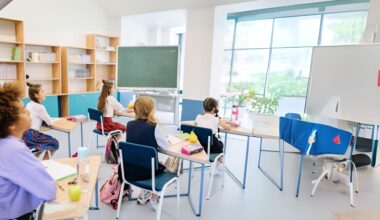As schools and educators continue to focus on academic achievement, there is a growing recognition of the importance of social-emotional learning (SEL) in fostering student well-being and success. While grades remain a primary measure of academic performance, they don’t fully capture the complexities of student growth, particularly in terms of their emotional and social development. Tracking social-emotional competencies is critical to understanding the holistic development of students and helping them navigate the challenges of school, relationships, and life.
In this blog, we will explore the significance of tracking social-emotional competencies in students, why it matters, and how educators and school systems can implement effective strategies to assess and support SEL growth.
What Are Social-Emotional Competencies?
Social-emotional competencies refer to the skills and abilities that allow individuals to manage their emotions, set goals, demonstrate empathy, establish positive relationships, and make responsible decisions. These competencies are foundational to mental health and well-being and play a critical role in shaping students’ academic success, interpersonal relationships, and overall life satisfaction.
The five core competencies of SEL, as defined by the Collaborative for Academic, Social, and Emotional Learning (CASEL), are:
- Self-awareness: The ability to recognize and understand one’s emotions, thoughts, and values.
- Self-management: The ability to regulate one’s emotions, thoughts, and behaviors in different situations.
- Social awareness: The ability to empathize with others and understand diverse perspectives.
- Relationship skills: The ability to establish and maintain healthy, positive relationships with others.
- Responsible decision-making: The ability to make constructive choices about personal behavior and social interactions.
When schools track these competencies, they move beyond traditional metrics like test scores and grades to provide a more comprehensive picture of student development.
Why Tracking Social-Emotional Competencies Matters
Social-emotional competencies are closely linked to academic performance, mental health, and long-term success. Here’s why tracking these competencies is so important:
- Enhancing Academic Success – Research has shown that students with strong social-emotional skills are better able to focus, manage stress, and engage with learning. By tracking SEL progress, educators can identify students who may struggle in these areas and offer targeted support, thereby improving academic outcomes.
- Promoting Mental Health and Well-being – Social-emotional skills help students cope with anxiety, depression, and other mental health challenges. Tracking SEL competencies allows schools to identify early signs of distress and provide intervention before issues escalate.
- Fostering Positive Relationships – Strong social-emotional skills are crucial for building positive relationships with peers and teachers. By monitoring SEL progress, schools can help students develop the skills necessary to navigate conflicts and work effectively in groups.
- Preparing Students for the Future – In the workplace and life, social-emotional skills are highly valued. Employers increasingly prioritize candidates who can collaborate, communicate, and handle stress. By tracking and fostering SEL competencies, schools prepare students for success beyond graduation.
How to Track Social-Emotional Competencies in Students
Tracking social-emotional competencies requires a more personalized and multifaceted approach compared to academic assessments. Here are several strategies that educators and schools can use to assess and support SEL growth:
- Student Self-Report and Questionnaires
One common way to track SEL competencies is through self-report questionnaires. These tools ask students to assess their own abilities in areas like emotional regulation, social interactions, and decision-making. While self-reporting can provide valuable insights, it’s important to combine it with other forms of assessment to ensure accuracy and depth. - Teacher Observations and Ratings
Teachers can provide valuable feedback on a student’s social-emotional development through direct observation and ratings. Teachers can use rubrics, assessments or checklists that assess specific SEL skills based on classroom behavior and interactions. This method provides a more objective perspective, balancing the subjective nature of self-report tools. - Peer Assessments
Peer feedback can be an effective way to gauge social-emotional skills, particularly in group work and collaborative settings. By encouraging students to reflect on how they interact with others, educators can gain additional insight into a student’s relationship skills, empathy, and communication abilities. - Journaling and Reflective Activities
Encouraging students to engage in journaling or reflective activities can provide them with opportunities to process their emotions, recognize patterns in their behavior, and set personal growth goals. These activities can help educators track a student’s progress over time and support them in their journey toward emotional regulation and self-awareness. - Digital Tools and Platforms
With advancements in technology, there are now a variety of digital tools and platforms designed to track SEL competencies. These tools often use a combination of assessments, surveys, and real-time data collection to provide educators with detailed insights into students’ social-emotional growth. - Student and Family Involvement
Engaging students and their families in the process of tracking SEL competencies ensures a well-rounded perspective. Students should be encouraged to set personal goals related to their social-emotional growth, and families can provide valuable insights about a child’s behavior and well-being at home. Collaboration between schools and families strengthens the support system for students’ development.
Implementing SEL Tracking in Schools
To effectively implement SEL tracking, schools must approach it with a clear strategy and commitment. Here are some best practices to help schools get started:
- Establish Clear Goals and Benchmarks
Schools should establish clear goals for what they want to achieve by tracking SEL competencies. This could include improving student behavior, reducing incidents of bullying, or enhancing emotional resilience. By setting specific, measurable goals, schools can track progress over time and adjust their strategies as needed. - Provide Professional Development for Educators
Teachers and school staff need training on how to assess and support SEL competencies. Professional development sessions can help educators understand the importance of SEL and provide them with the tools they need to track progress effectively. - Integrate SEL into the Curriculum
SEL should not be an afterthought or an add-on. Schools should integrate social-emotional learning into the daily curriculum, making it a core part of students’ educational experience. This could include explicit SEL lessons or incorporating SEL themes into academic subjects. - Ensure Consistent and Ongoing Monitoring
Tracking social-emotional competencies is not a one-time event but an ongoing process. Schools should regularly monitor students’ SEL progress, adjust interventions as needed, and celebrate successes. This consistency ensures that SEL remains a priority and that students receive the support they need to thrive.
Conclusion
Tracking social-emotional competencies is essential for supporting the well-being and success of students. By moving beyond traditional academic measures and focusing on emotional and social development, schools can provide a more holistic view of student growth. The strategies outlined in this blog, from self-assessments to teacher observations, offer practical ways to track SEL progress and support students’ emotional growth. In doing so, schools will not only improve academic outcomes but also foster the skills necessary for students to thrive in school, relationships, and life beyond the classroom.
By recognizing the value of social-emotional competencies, schools can help students become well-rounded individuals equipped to face the challenges of the world with confidence and resilience.



